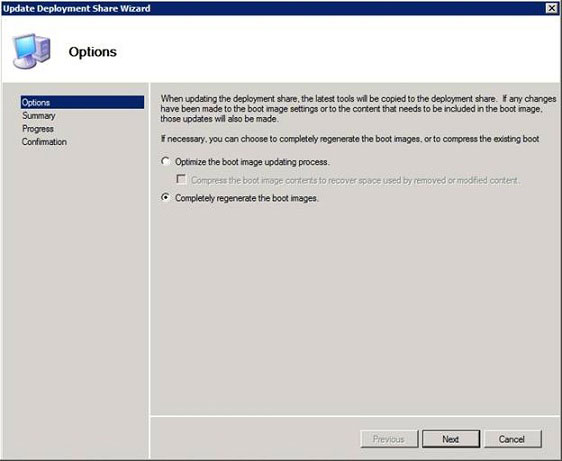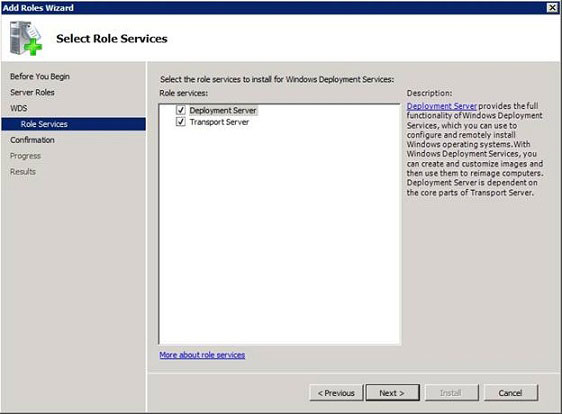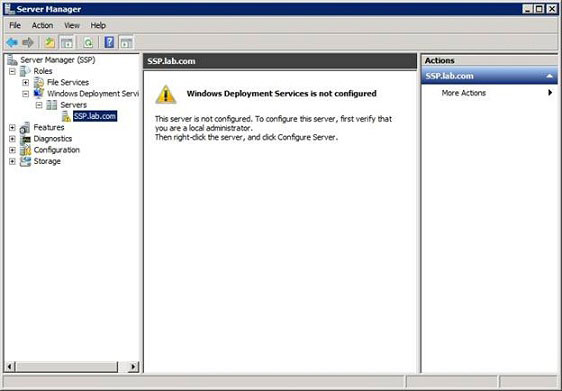Create private cloud with Hyper-V (Part 3)
TipsMake.com - In the previous lesson, we created the Hyper-V task sequence. Now is the time to make this task sequence change so that we can use them to create Hyper-V servers that manage virtual machines in the private cloud.
Introduce
The previous article showed users how to extract the contents of Windows installation media to create an executable image file. We have created two task sequences that are deploying the generic Windows Server 2008 R2 and Windows Server 2008 R2 client running Hyper-V. In this article, we will modify the Hyper-V task sequence setup to use to deploy Hyper-V server to manage virtual machines in the cloud.
Reconfigure the task sequence
Open Deployment Workbench and find control trees to Deployment Workbench | Deployment Shares | MDT Deployment Share | Task Sequences | OS Install . Now, right-click the task string we created for Hyper-V and select Properties from the pop-up menu. The attribute table will appear.
Select the Task Sequence tab in the properties table. This tab can be used to modify the current workflow. Since we are creating a Hyper-V server, we will need to install the task for the Hyper-V server. To do this, select the Tattoo option from the task sequence and then select Roles | Install Roles and Features from the Add menu. A detailed information frame displays a sequence of tasks (roles) and features that can be installed. Check the Hyper-V box (c64 only) .

You should check the Multipath I / O (Core) box . This option makes it easier to connect to the repository later. After selecting the components you want to install, click Apply then click OK .
Update to public folder
At this point, the user must update the public folder. Otherwise, the job sequence created will not work. To do this, look through the control tree to Deployment Workbench | Deployment Shares | MDT Deployment Share . Next, right-click the MDT Deployment Share folder and select Update Deployment Share from the pop-up menu.
An installation window will appear asking users if they want to optimize the boot image file to update the process or want to completely recreate the boot image file. At this point, choose to completely recreate the boot image file as shown below.

Click Next to see the summary screen confirming the selected action. Click Next again to create executable image files. Completion time depends on hardware configuration.
Install Windows Deployment Services
The next step is to install the executable services on the server running the Deployment Workbench from the Server Manager manager. Open Server Manager and select the Roles folder. Click the Add Roles link to let Windows launch the Add Roles installation window.
Click Next to bypass the Welcome screen. A screen will ask the user who wants to install for any task. Select Windows Deployment Services and click Next . A screen introducing the execution services appears. Click Next to bypass this screen.
Next, the program will ask which service (role service) that users want to install. There are two options: Deployment Server and Transport Server. Please select both, as shown below.

Click Next and then click Install . Windows will install Windows Deployment Services. After completing the installation, click Close .
Configure Windows Deployment Services
Now, Windows Deployment Services has been installed and must be configured. Look in Server Manager to Roles | Windows Deployment Services | Servers |

Right-click the server and select Configure Server from the menu. When the configuration window appears, click Next to bypass the introduction screen.
The next screen asks for the path to the remote installation directory. If possible, users should save this folder in a folder other than the C: drive.
Click Next . The installation window will ask how the user wants the server to process requests from the client. Select the option to enable all clients (know or not) then click Next . Windows will configure and start Windows Deployment Services. Once completed, you will see a screen asking if you want to add image files to the server now. This option is enabled by default but you need to uncheck it because we are using the Deployment Workbench for image files. Click Finish to complete the configuration process.
Add image files
Now, add some executable image files to Windows Deployment Services. To do this, look in Server Manager to Role | Windows Deployment Services | Servers |

Click Next to enter the image file name. Then, click Next a few more times to import the image file. Once done, click Finish .
Conclude
At this point, we have created a boot image file that can be deployed, but we still have a long way to go if we want to use this technique to create our own cloud.
You should read it
- Create private cloud with Hyper-V (Part 5)
- Create virtual cloud with Hyper-V (Part 6)
- Create private cloud with Hyper-V (Part 2)
- How to import Hyper-V virtual machines in Windows 10
- How to export Hyper-V virtual machines in Windows 10
- Use the Virtual Machine Manager to quickly deploy Hyper-V
- Create virtual machines with Hyper-V on Windows 8 and Windows 10
- Create virtual machines in Hyper-V on Windows Server 2008
May be interested
- Learn about Public Cloud, Private Cloud and Hybrid Cloud
 there are many different ways to deploy and exploit cloud computing resources.
there are many different ways to deploy and exploit cloud computing resources. - Instructions for using Hyper-V on Windows 8 (Part 1)
 one of the new features on windows that is most noticeable is the hyper-v virtualization program to meet users' need to create windows virtual machines. the article will guide readers to activate and use the program on windows 8.
one of the new features on windows that is most noticeable is the hyper-v virtualization program to meet users' need to create windows virtual machines. the article will guide readers to activate and use the program on windows 8. - How to create a shortcut Hyper-V Manager in Windows 10
 hyper-v, which allows running virtualized computing systems on physical servers. this tutorial will show you how to create a hyper-v manager shortcut in windows 10.
hyper-v, which allows running virtualized computing systems on physical servers. this tutorial will show you how to create a hyper-v manager shortcut in windows 10. - Virtual network for Hyper-V - Part 2
 in part 2 of this series, i will continue the discussion by talking about virtual networking on hyper-v by studying the communication between partitions.
in part 2 of this series, i will continue the discussion by talking about virtual networking on hyper-v by studying the communication between partitions. - How to enable and use Hyper-V on Windows 10
 windows 10 is equipped with hyper-v to help users create virtual machines directly without using third-party software. let's see how to activate and use hyper-v on windows 10 through the simple steps below.
windows 10 is equipped with hyper-v to help users create virtual machines directly without using third-party software. let's see how to activate and use hyper-v on windows 10 through the simple steps below. - How to rename Hyper-V virtual machines using PowerShell and Hyper-V Manager
 sometimes when you create a hyper-v virtual machine, you must give it a name and sometimes the naming is incorrect or simply you no longer want to use that name. this article will provide three methods to rename a hyper-v virtual machine to your liking.
sometimes when you create a hyper-v virtual machine, you must give it a name and sometimes the naming is incorrect or simply you no longer want to use that name. this article will provide three methods to rename a hyper-v virtual machine to your liking. - Multicloud - a new step in cloud computing technology
 you may think that 'multicloud' and 'hybrid coud' are the same, but no, they are different stages in the development of cloud computing.
you may think that 'multicloud' and 'hybrid coud' are the same, but no, they are different stages in the development of cloud computing. - Create virtual machines in Hyper-V on Windows Server 2008
 after hyper-v is installed, the first thing to do here is to create a virtual machine - virtual machine. in the following article, we will introduce you to some basic steps to do this, with the general implementation process almost just clicking next> next> finish.
after hyper-v is installed, the first thing to do here is to create a virtual machine - virtual machine. in the following article, we will introduce you to some basic steps to do this, with the general implementation process almost just clicking next> next> finish. - How to create and use Hyper-V checkpoints in Windows 10
 checkpoint is a powerful feature of hyper-v, making it easy to undo all changes on a virtual machine.
checkpoint is a powerful feature of hyper-v, making it easy to undo all changes on a virtual machine. - Instructions for installing Hyper-V
 to install hyper-v, open the server manager tool and click the add roles link. next, in the select server roles dialog box, click on the hyper-v role. at this point, follow the step-by-step instructions to install hyper-v on the server.
to install hyper-v, open the server manager tool and click the add roles link. next, in the select server roles dialog box, click on the hyper-v role. at this point, follow the step-by-step instructions to install hyper-v on the server.










 Create private cloud with Hyper-V (Part 4)
Create private cloud with Hyper-V (Part 4) Create private cloud with Hyper-V (Part 5)
Create private cloud with Hyper-V (Part 5) Create virtual cloud with Hyper-V (Part 6)
Create virtual cloud with Hyper-V (Part 6) Monitor Hyper-V with the command line (Part 3): Check virtual machine status
Monitor Hyper-V with the command line (Part 3): Check virtual machine status Technical Network Address Translation (NAT)
Technical Network Address Translation (NAT) Monitor Hyper-V with the command line (Part 4)
Monitor Hyper-V with the command line (Part 4)